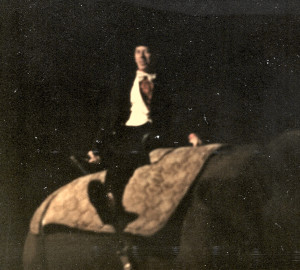Category Archives: YouTube
President Obama shooting buckets
The president, a former high school player and avid basketball fan, prevailed in a brief, impromptu game of P-I-G with a few players from UConn’s women’s team.
Mays in center field
The Day the Circus Came to Town

Recently unearthed (bad) photo of me astride the majestic beast. (1981)
Green Screen (NYC street scenes)
My friend Wendy came through with some NYC street video for my green screen hijinx. I’ve been sitting on it for a week or two, desperate to come up with something imaginative to do with it. I did not. But I will.
Concrete Man (Director’s Cut)
Clarence Lee Sherrill and Crista Meyer sell concrete lawn ornaments. Their business is called Concrete Castings and they’re located on I-55 just north of Cape Girardeau, MO. I have a strange fascination with “yard art” and decided to scratch the itch on a recent trip down south.
Clarence and Crista work in a small, cluttered room heated by a big wood stove and covered in cement dust. Gazing in a large window was a magnificent peacock. I didn’t see Miss C, the camel that’s usually in a pen out front, and Clarence explained she was “visiting her boyfriend” but would return in a few days. Gotta be tough to breed camels in this country.
On a technical note, I shot the video with the Casio Exilim FC100, but the battery went dead on me. So I recorded a few minutes of audio on the iPhone and dropped in some stills. You’ll notice the change in audio quality.
Will Ferrell: You’re welcome, America
Sen. McCaskill Flips and Twitters Missouri reporters
“After finishing a serious interview with a trio of reporters on various topics, Sen. Claire McCaskill suddenly whipped out her own mini-cam to turn the tables. McCaskill apparently wanted to put Tony Messenger, Jo Mannies and I in the uncommon role of answering questions. Then, I begin filming McCaskill’s experiment shooting us. The Senator asked for quick soundbites and hit me with a tough criticism about my own blog — that it’s video heavy.”
— Springfield TV reporter David Catanese
Burma VJ: “I was filming when the soldiers came.”
Thanks to Melody and Nathan for treating us to the powerful documentary Burma VJ, part of Columbia, MO’s True/False Film Festival.
“A tense suspense thriller in the guise of a new-form political documentary, begins in 1988, when Burma’s military junta brutally shot and killed 3,000 demonstrators, imprisoned opposition leader Aung San Suu Kyi, and outlawed independent journalism. In the years since, the Democratic Voice of Burma, a “television station in exile,” has begun sneaking images of the repression out of the country. Using cheap handicams, cell phones, short-wave radio and satellite feeds, the DVB transmits startling footage across the globe, fueling international outrage against the totalitarian government. When the nation’s Buddhist monks decide to take to the streets in September 2007, joined by tens of thousands of students, the DVB was there, allowing the world to watch both this event and its brutal aftermath. A testament to the courage of journalists and a cautionary tale for dictators, Burma VJ is truly inspiring.”
Nathan figured I’d enjoy this film because he reads this blog and knows I’m interested in journalism/media/video. And he was right. This story grabbed me from the beginning.
If I could ask one of the generals who control Burma just one question, it would be: Which is the greater threat to your dictatorship, guns or video cameras?
At the end of the film, the director, Anders Ostergaard, talked about the film and the audience was invited to donate money that would be used to buy more and smaller cameras for the DVB (smaller cameras are less likely to be discovered).
I take for granted that I can take a photograph, shoot some video or make an audio recording in any public place. And then publish it here for the world to see. I’ll try to remember there are others risking their lives and freedom to do so. One of my favorite lines from the film: “Those who are not afraid to die,come to the front.”
I assume Burma VD will be available on DVD, if it’s not already. I encourage you to watch it.
